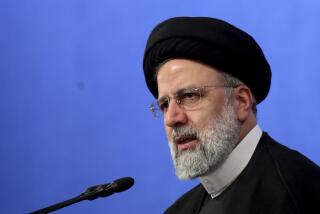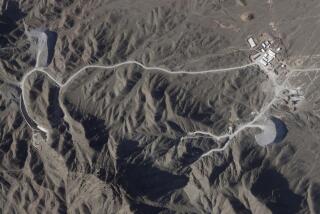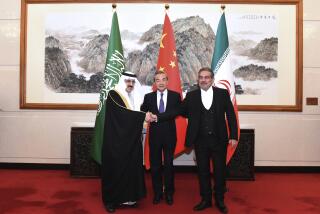Disagreements cloud who won and lost in the Iran nuclear deal
An outpouring of details from the Obama administration on the preliminary nuclear deal with Iran suggests the U.S. and five partner countries emerged from 18 month of talks with an agreement tilted very much in their favor.
The major powers did surprisingly well in some highly sensitive areas. But a long list of issues remains in dispute and must still be negotiated. On some points, it looks like Iran is likely to come out ahead.
Iranian officials didn’t endorse many of the points detailed in the five-page fact sheet that the White House emailed around the world after the talks concluded Thursday night.
Indeed, Tehran’s version of events sounded considerably different.
World powers scored points in winning pledges that the inspections of Iran’s nuclear facilities by international nuclear experts will be highly intrusive. Radio transmitters, for instance, will be clamped on Iran’s centrifuges to sound the alarm if somebody starts tampering with them.
“If Iran cheats, the world will know it,” President Obama declared. Iran will “face more inspections than any other country in the world.”
The diplomatic bloc facing Iran - the United States, England, France, Germany, Russia and China - scored in limiting Iran’s inventory of operating centrifuges to just over 5,000, about half the current total operating. The machines will be at one site, not two, as they are now.
They also did well to require that Iran use only their balky first-generation IR-1 centrifuges, built with 1970s technology, that would slow any enrichment effort. And Iran, which has enriched uranium to 20% purity in the past, agreed to limit all enrichment to 3.67%, far below what’s necessary to build a bomb.
Forcing Iran to rely on the old machines makes it is likely that the world powers will have powerful restraints on Iran’s ability to race to complete a bomb in the next decade “and likely beyond,” Jofi Joseph, a former nonproliferation aide in the Obama White House, wrote in an email.
Iran’s apparent agreement to redesign and rebuild its Arak heavy-water nuclear reactor to prevent it from turning out weapons-grade plutonium also is a win for the West. It shuts down another pathway for Iran to build a bomb.
U.S. Secretary of Energy Ernest Moniz, a nuclear physicist who played a key role in the talks, said experts from U.S. national laboratories are “very confident in the technical underpinnings of this agreement.”
In a statement, Moniz said Iran currently could amass enough enriched uranium within two to three months to build a bomb. The proposed deal, he said, expands the so-called breakout timeline “to a minimum of a year, for at least the next 10 years.”
But other U.S. claims will be very much in dispute when Iranian and international negotiators resume talks in the next few days, probably in Vienna, to try to complete a permanent deal by a self-imposed deadline of June 30.
Moniz and other U.S. officials said Iran’s current stockpile of low-enriched uranium will be reduced by 98%, to 300 kilograms from 3,000, for the next 15 years.
Iran hasn’t conceded those numbers. And they haven’t committed on how they will pare their stockpile: whether by shipping the material to Russia, as they had apparently promised last year, or by diluting it or turning it into an oxidized form that could not be used for nuclear weapons.
Export of the enriched material would give the outside world much greater reassurance that it would not be diverted and upgraded for possible use as bomb fuel, many experts say.
The two sides also offered quite different accounts of how quickly, and how completely, economic sanctions will be lifted on Iran.
Iran says the penalties will be removed at the start, and the lifting would be permanent. U.S. officials say sanctions will be suspended in phases, probably starting next year, and could be reimposed if Iran is judged not in compliance with its commitments.
Negotiations in this area are likely to be brutal, since Iran needs a quick economic boost from sanctions relief to satisfy its long-suffering public and to muffle criticism from hard-liners who oppose any compromise with the West.
The U.S. and its allies didn’t seem to make much headway on nailing down Iran’s possible past research into nuclear weapons.
The fuzzy language used by the Obama administration makes it unclear whether resolution of these issues--a key concern of the International Atomic Energy Agency, the United Nations watchdog agency--are a condition that Iran needs to satisfy as part of the final deal.
Officials also were vague on how world powers are going to punish any Iranian rule-breaking. That’s a big issue to skeptics in Congress and elsewhere because rule-breaking in such agreements often leads to tangled legalistic and diplomatic disputes rather than a forceful response.
Secretary of State John F. Kerry said the agreement has “no sunset, none,” arguing that some limits will remain in perpetuity.
But the times set out in any agreement will come under fierce scrutiny by congressional critics. After 10 years, Iran will be able to start deploying its more advanced centrifuges, giving it greater capability to enrich uranium and shorten the breakout time should it decide to race for a bomb.
Another question likely to trouble Congress is what happens at the Fordo enrichment site, which is deep underground. Iran’s been allowed to keep 1,000 centrifuges at the site under IAEA control, though not to stockpile or enrich uranium.
A key question will be whether Iran will be able to start using advanced machines at Fordo, “thereby acquiring a quick and secure route to the bomb,” Cliff Kupchan, chairman of the Eurasia Group risk analysis firm, wrote in an analysis. “The back end provisions of the accord are vulnerable.”
More to Read
Start your day right
Sign up for Essential California for news, features and recommendations from the L.A. Times and beyond in your inbox six days a week.
You may occasionally receive promotional content from the Los Angeles Times.







